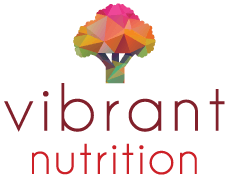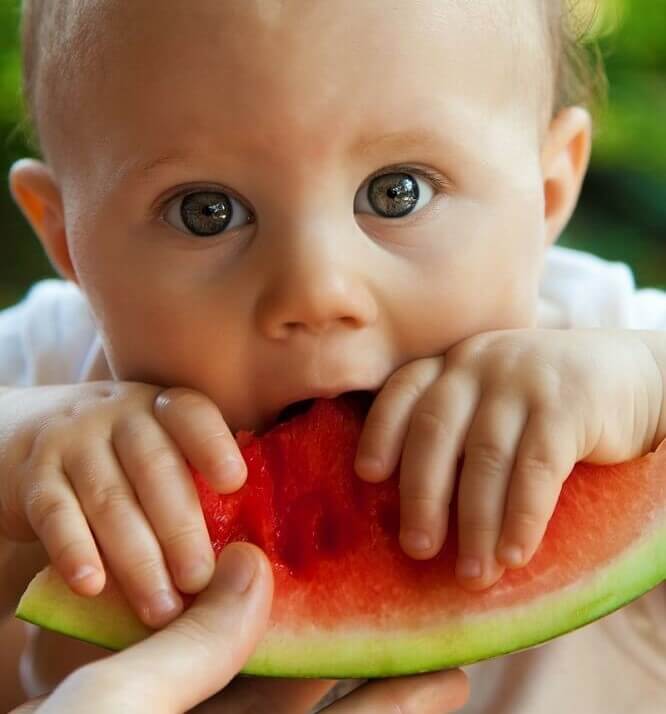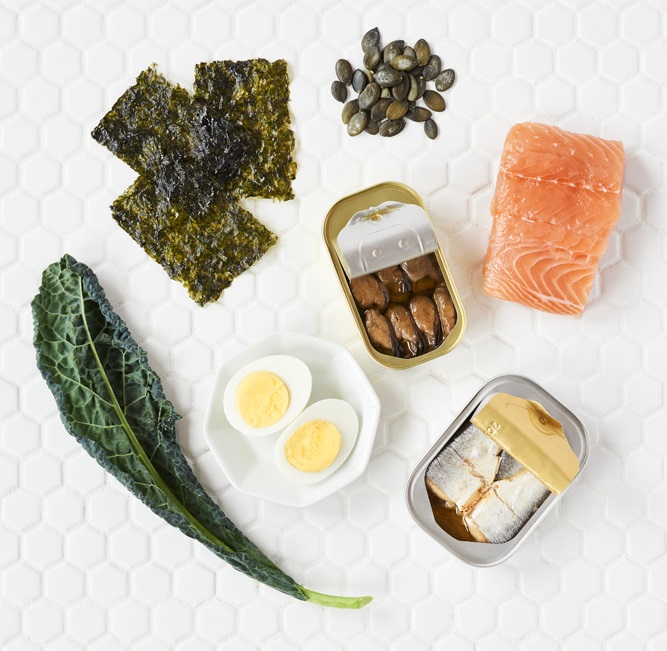June 9th, 2017
Everything you Ever Wanted to Know about Baby-Led Weaning
Baby-led weaning – I bet you hear this phrase at least once a day in your life as a new or soon-to-be parent!
“Baby-Led Weaning” seems to be a trendy new catch-phrase in parenting groups articles, but it’s actually not a new concept at all!
So what exactly is baby-led weaning? And is it the best way to feed a baby anyways? Find out below as I uncover the pros, cons, and common questions about this “not-so-new” concept for starting solids.
What IS baby-led weaning?
Simply put, baby-led weaning is a method of starting your baby on solids.
Usually the baby is in a high-chair, where they are eating pieces of food using their hands, rather than being fed by you with a spoon, with no purées or liquefied textures required.
Often, after one child, feeding a second or multiple children is about practicality vs. perfection, as it should be! Second and consecutive children are also greatly influenced by watching their siblings eat and put little morsels into their mouths, and wish to copy this behaviour and join the fun earlier than their first-child counterparts.
Babies are much happier when they have autonomy in feeding and are allowed to feed themselves. This is why, among other changes, self-feeding is one of the recommendations of our new(ish) Health Canada Paediatric Feeding Guidelines from 2012.
Why the change from purées?
To understand why purées have been a baby-feeding staple for so long, it’s important to know that the optimal age to start feeding your baby has been slowly moving forward as we learn more about pediatric health.
In the 1960s, 3 months was the standard age to start weaning babies, which was early compared to the current standard of 6 months. Purées made sense back then – when you are looking down at a little 3 month old baby, there is no way they can hold anything, bring it to their mouths or sit upright and unassisted, which are ALL things that are required to start baby-led weaning. Puréed foods and liquefied foods would have been the only solid food of choice for babies this young. Puréed foods such as pabulum, rice cereals, fruits, or single meats would be introduced one-at-a-time, and then they would eventually move to more mashed textures.
The current consensus, including the WHO and the Canadian Paediatric Guidelines, is that 6 months old is the optimal time to start feeding your baby solid/complimentary food. By 6 months of age, babies have developed strong necks, and musculature that allows them to sit upright in a supportive high-chair. Many babies have developed their “pincer grip” at this age; meaning they can independently bring their pointer finger and thumb together to grip a small object. Their little hands and fingers are already grabbing, raking and playing with everything, which is why finger foods are such a perfect thing to introduce.
So, do you just throw a carrot on your baby’s tray when they reach their 6- month birthday? Not exactly…the process can still happen gradually and there are some pros and cons, which we’ll go over below.
What are the benefits of baby-led weaning?
It can be a wonderful feeding to finally sit down at the table with ALL your family members, even the wee ones and actually eat together, sharing largely the same foods but in different shapes and sizes. Babies love nothing more than to be with us and watch what we do! A positive eating environment where baby eats the same things we do is one of the keys to a happy baby and is a driver for life-long healthy eating behaviours.
The instant role-modeling that can happen with a baby-led weaning approach has some experts believing that is may reduce the chances your baby will refuse foods and be more fussy or challenging eaters when they grow up – some people call them “picky eaters”, but I DETEST that word (see my blog post, PLEASE Don’t Call Your Child a Picky Eater). If you are struggling with a challenging eater, you may be interested in my upcoming workshop on this topic – click here for more details.
Another benefit of baby-led weaning is that earlier introduction of textural variety can mean earlier acceptance of foods that must be chewed. Earlier introduction to self-feeding practices and textural variety are both key parts of our feeding guidelines in Canada.
What are the risks of baby-led weaning?
Even if it’s your goal as a parent to use baby-led weaning, your baby may not be developmentally ready to chew and swallow whole food when you are ready.
Each child is different and though there are average ages for development to happen, some babies require a slower transition with purée or mashed foods before they are able to handle larger pieces of food, finger foods etc. Your baby is an individual, treat them like one! If you have ever noticed an incident when baby put food into their mouth, maybe taken from you or a well-meaning sibling, and had difficulty swallowing, you may need to start with a few runs of purées first.
Even if your baby is able to chew and swallow these finger foods, they may not take in the amount of calories that they need. If you are trying baby-led weaning, watch for signs that your baby is still hungry or unsatisfied at the end of meals. You can always offer puréed foods alongside the finger foods, and you can even give your baby a spoon to begin to familiarize them with utensils.
The baby-led weaning diet can be limited if you are not very creative in the kitchen. It can be hard to create variety in the finger-food format. One of the potential risks of baby-led weaning is that if your baby could miss out on the full range of nutrients they require for growth and development with finger foods alone. This can diets too low in iron, zinc and total energy. You need to serve a range of foods throughout the day at meals and snacks to cover the base and expose baby to lots of variety and taste. You can use finger foods along with some purées to cover these bases more completely should you feel you are serving the same things all the time.
One last risk is judgement and surprise from family and friends, which can feel awful! I have definitely had to make phone-calls to concerned spouses and grandparents who were very unsure about the feeding style for their grandchild. But, you’re already a parent, so being judged is nothing new! Have an answer that uses curiosity and humour to buffer any negative responses to feeding your baby baby-led-weaning-style, such as “Isn’t it amazing what babies can do safely for themselves?!”
Won’t my baby choke?
Choking and gagging are the top concerns of parents who choose this style-of feeding. When a baby can sit upright, and has the ability to handle their own food in their mouths, moving it back to be swallowed, this means the risk of choking is minimal.
Sometimes parents who weaned older children on purées are not as accustomed to the gagging and swallowing processes that some babies go through as they eat. If you feel nervous or anxious, remember to speak to a professional for guidance such as your child’s doctor or a pediatric dietitian.
Are there any babies for whom baby-led weaning isn’t the right choice?
If you have been told your baby is not growing or developing appropriately, has been described as Failure to Thrive, is not trending on their own growth curve, has special needs and or developmental delay, was born as a premature baby, or has digestive issues, or food intolerances and allergies, baby-led weaning may not be the most suitable option.
In these cases, the best way to find out the right plan for feeding your baby is to speak to a professional registered dietitian.
How do I do start baby-led weaning?
Try creating “chip-sized” or “french-fry shaped” foods that baby can pick up in their little hands and bring to their mouth. For example, a food that is easy to prepare this way is a spear of cooked broccoli, so that the baby would have the florets wend in their mouth.
Many babies will not have that pincer-grip developed right at 6 months, and will benefit from foods in these shapes, as if they have a built-in handle.
Here are a few guidelines to get you started:
- Do sit together at meals
- Do place baby in a supportive high-chair with their own tray or mat to eat from
- Do offer baby foods at mealtimes with the family that are age and size appropriate finger foods
- Never leave your child unattended while they are feeding themselves
- Never take pieces of food or finger-foods and place them into your baby’s mouth
Some final things to keep in mind:
- Baby-led weaning doesn’t always make your life easier just because there are no purées
- It’s VERY VERY messy! Your dog will be in heaven with this new baby food delivery service
- Playing with food is part of learning and having fun with food, so don’t stress if at first very little is going into the mouth
- Keep breastfeeding to before naps and in-between meals, the scheduling of feeds will change as baby begins eating more solid foods
If you have questions or concerns about this process, why not come work with me! Click here to contact me about an appointment.
Happy feeding!



